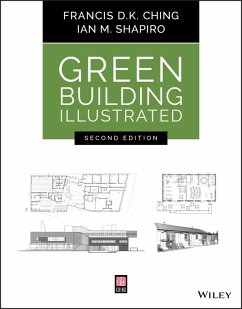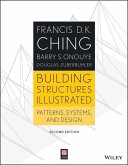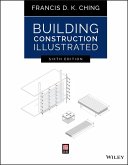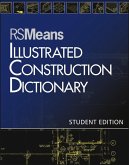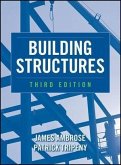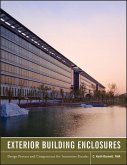FULLY ILLUSTRATED, UPDATED GUIDE TO THE STRATEGIC DESIGN OF GREEN BUILDINGS In the tradition of Building Construction Illustrated, Francis D.K. Ching and Ian M. Shapiro offer a fully illustrated guide to the theory and practice of sustainable design. This guide provides architects, designers, and builders in the green design professional community a framework and detailed strategies for designing substantively green buildings. With a focus on sustainable sites, approaching and reaching net-zero energy, low and zero-water usage, minimum-impact materials and superior indoor environmental quality, this guide explains why we need to build green, as well as green building theory and advancements in the industry. This Second Edition includes: * All-new case studies featuring geographically diverse buildings with proven zero energy performance * Expanded coverage of zero energy building design, as well as zero water and zero waste buildings * Practical guidance for the schematic design of high-performance buildings, heating and hot water system selection, building envelope details, and integrating renewable energy * Advanced strategies, such as the concept of shape efficiency, and the optimal location for stairwells in buildings * Additional strategies for affordability in green design and construction * Updated references to the latest codes and standards This Second Edition of Green Building Illustrated is an excellent resource for professionals, students and those interested in the design and construction of sustainable buildings.
Dieser Download kann aus rechtlichen Gründen nur mit Rechnungsadresse in A, B, BG, CY, CZ, D, DK, EW, E, FIN, F, GR, HR, H, IRL, I, LT, L, LR, M, NL, PL, P, R, S, SLO, SK ausgeliefert werden.
"Buildings account for one third of greenhouse emissions. Green Building Illustrated offers practical solutions presented in the visual language of architects, builders, and designers. Elegant drawings and clear conceptual explanations lead students and practitioners to an intuitive understanding of the deep technical knowledge for eco-friendly design. Zero Energy Buildings, sustainability, embodied energy, building envelopes, systems integration, passive solar strategies, biomimetic architecture, carbon footprint...they're in there. Planet earth needs this book!"
--Ron Judkoff, Chief Architectural Engineer, National Renewable Energy Laboratory
"When the first edition of Green Building Illustrated came out in 2014, I thought it was clearly written and illustrated, and packed with good information for aspiring architects and engineers, as well as veteran building and mechanical design professionals. The tone is conversational and not didactic or preachy. It doesn't provide the reader with black and white solutions to every problem but sets out a range of possibilities.
The second edition does the above and more so. It questions whether we can continue to use fossil fuels in buildings; mitigate the worst effects of Global Climate Change; and still provide well designed, well built, comfortable, healthy, and sustainable buildings. Along with some minor changes made for greater clarity, the new edition provides, for example, much more detail about heat pumps, an expanded treatment of stairways in multifamily buildings, and includes a new chapter devoted to case studies from net-zero buildings from around the world. In other words, the second edition continues the conversation among professionals who are passionate about sustainable buildings and a sustainable planet, who are thoughtful, well grounded in the basics of physics and building science, but who are open to finding new solutions to the problems we face in a changing environment."
--Jim Gunshinan, Senior Editor, Building Performance Journal (previously, Home Energy magazine)
"The authors of Green Building Illustrated frame existing and emerging challenges of green building with clarity and care, and provide a compelling science-based design approach that complements, rather than competes with, existing sustainable codes and standards.
This widely applicable and intuitive source encourages design students and professionals to consider sustainability as an evolving art, and to allow energy and material conservation principles to guide design problem-solving with rigor and creativity."
--Nina Sharifi, Ph.D., Syracuse CoE Faculty Research Fellow, Assistant Professor, School of Architecture, Syracuse University
--Ron Judkoff, Chief Architectural Engineer, National Renewable Energy Laboratory
"When the first edition of Green Building Illustrated came out in 2014, I thought it was clearly written and illustrated, and packed with good information for aspiring architects and engineers, as well as veteran building and mechanical design professionals. The tone is conversational and not didactic or preachy. It doesn't provide the reader with black and white solutions to every problem but sets out a range of possibilities.
The second edition does the above and more so. It questions whether we can continue to use fossil fuels in buildings; mitigate the worst effects of Global Climate Change; and still provide well designed, well built, comfortable, healthy, and sustainable buildings. Along with some minor changes made for greater clarity, the new edition provides, for example, much more detail about heat pumps, an expanded treatment of stairways in multifamily buildings, and includes a new chapter devoted to case studies from net-zero buildings from around the world. In other words, the second edition continues the conversation among professionals who are passionate about sustainable buildings and a sustainable planet, who are thoughtful, well grounded in the basics of physics and building science, but who are open to finding new solutions to the problems we face in a changing environment."
--Jim Gunshinan, Senior Editor, Building Performance Journal (previously, Home Energy magazine)
"The authors of Green Building Illustrated frame existing and emerging challenges of green building with clarity and care, and provide a compelling science-based design approach that complements, rather than competes with, existing sustainable codes and standards.
This widely applicable and intuitive source encourages design students and professionals to consider sustainability as an evolving art, and to allow energy and material conservation principles to guide design problem-solving with rigor and creativity."
--Nina Sharifi, Ph.D., Syracuse CoE Faculty Research Fellow, Assistant Professor, School of Architecture, Syracuse University

